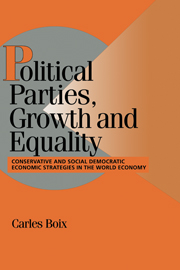 Political Parties, Growth and Equality
Political Parties, Growth and Equality Published online by Cambridge University Press: 05 June 2012
The economic policies developed by the González government closely fit our theoretical expectations (and statistical results) about the policy choices made by social democratic cabinets in an era of highly interdependent economies. In Spain, macroeconomic discipline was given precedence over countercyclical demand management. Inflation was driven down from 14.4 percent in 1982 to 4.8 percent in 1988. The public deficit was cut by half between 1982 and 1987. Within a deflationary framework, the Socialist cabinet directed the public sector to raise the stock of fixed and human capital. Public revenues rose by over a fifth in a decade. Until the late 1980s almost all new revenues were spent on increasing public savings, building infrastructures, and financing education and training programs. Public businesses in key sectors stepped up investment and the government engaged in the formation of several internationally competitive “national champions.”
Nevertheless, the PSOE's two-pronged economic strategy of macroeconomic stability and state interventionism was constrained by two factors: in the first place, Spain's industrial relations system and union movement; in the second place, the increasing difficulties González experienced in reconciling the demands of (anti-tax) moderate voters and (pro-spending) radical voters, who had jointly supported him in the first half of the 1980s.
The institutional organization of the Spanish economy, particularly the structure of its labor market, was only partially conducive to the PSOE's most preferred strategy.
To save this book to your Kindle, first ensure [email protected] is added to your Approved Personal Document E-mail List under your Personal Document Settings on the Manage Your Content and Devices page of your Amazon account. Then enter the ‘name’ part of your Kindle email address below. Find out more about saving to your Kindle.
Note you can select to save to either the @free.kindle.com or @kindle.com variations. ‘@free.kindle.com’ emails are free but can only be saved to your device when it is connected to wi-fi. ‘@kindle.com’ emails can be delivered even when you are not connected to wi-fi, but note that service fees apply.
Find out more about the Kindle Personal Document Service.
To save content items to your account, please confirm that you agree to abide by our usage policies. If this is the first time you use this feature, you will be asked to authorise Cambridge Core to connect with your account. Find out more about saving content to Dropbox.
To save content items to your account, please confirm that you agree to abide by our usage policies. If this is the first time you use this feature, you will be asked to authorise Cambridge Core to connect with your account. Find out more about saving content to Google Drive.